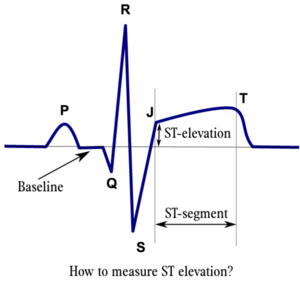We need you! Join our contributor community and become a WikEM editor through our open and transparent promotion process.
ST segment elevation
From WikEM
Contents
Background
- Its presence must be explained (there is no "nonspecific ST elevation")
- Not a specific marker for STEMI
Evaluation

Measure ST elevation at the j-point[1]
Early Repolarization versus STEMI
- Early Repolarization suggested by:
- ST elevation <4mm
- Notched J point
- Concave or saddle-back ST morphology
- No reciprocal changes
LVH versus STEMI
- Difficult to exclude MI in patient with LVH (patients with LVH are already at risk for MI)
- Best aid is prior ECG or serial ECGs
LBBB versus STEMI
STEMI
- ST elevation in those leads that reflect the distribution of a single coronary artery
- RCA: II, III, aVF (inferior)
- LAD: V1-V4 (antero-septal)
- Circumflex: V5-V6, I, aVL (lateral)
- Dominant left circulation: infero-lateral
- ST morphology
- Concave up versus convex
- Convex has Sp 97%, Sn 77%
- Concave up versus convex
- Look for reciprocal ST depression
- 35% of anterior STEMI have ST depression in inferior leads
- 80% of inferior STEMI have ST depression in anterior leads
- However, may represent reciprocal changes OR posterior STEMI
Stages of Development
- Stage 1
- Timing: 30min - hours
- Finding: hyperacute T waves
- >6mm limb leads
- >10mm precordial leads
- Duration: normalizes in days, weeks, or months
- Stage 2
- Timing: minutes - hours
- Finding: ST segment elevation
- ≥0.1mV in two or more contiguous leads
- Duration: ST segment resolution occurs over 72hrs; completely resolves within 2-3wks
- Stage 3
- Timing: within 1hr; completed within 8-12hr
- Finding: Q waves
- Duration: persist indefinitely in 70% of cases
- a: 30min after chest pain onset
- b: 45min after chest pain onset (hyperacute T waves)
- c: 70min after chest pain onset (ST elevation)
- d: 3hr after PCI (ST segment has decreased, TWI incdicates reperfusion)
- e: 5 days after PCI (ST segment back to baseline, TWI is near baseline)
Reciprocal Changes
- Anterior STEMI
- Reciprocal ST-segment depression in at least one of leads II, III, aVF
- Occurs in 40-70% of cases
- Inferior STEMI
- Reciprocal ST-segment depression usually present in I, aVL; often in V1-V3
- Occurs in 56% of cases
- Posterior STEMI
- Reciprocal ST-segment depression in V1-V4
- Differentiate from inf STEMI reciprocal depression based on upright T waves, posterior leads showing STEMI
- Often associated with ST-segment elevation in II, III, aVF (inferior involvement)
- Reciprocal ST-segment depression in V1-V4
Differential Diagnosis
ST Elevation
- Myocardial infarct (STEMI)
- Post-MI (ventricular aneurysm pattern)
- Previous MI with recurrent ischemia in same area
- Wellens' syndrome
- Coronary artery vasospasm (eg, Prinzmetal's angina)
- Coronary artery dissection
- Drugs of abuse (eg, cocaine, crack, meth)
- Pericarditis
- Myocarditis
- Aortic dissection in to coronary
- LV aneurysm
- Early repolarization
- Left bundle branch block
- Left ventricular hypertrophy (LVH)
- Pneumomediastinum
- Pneumothorax
- Pulmonary Embolism
- Myocardial tumor
- Myocardial trauma
- External compression of artery
- Medications: Tricyclic (TCA) toxicity, Digoxin
- RV pacing (appears as Left bundle branch block)
- Hyperkalemia (only leads V1 and V2)
- Hypothermia ("Osborn J waves")
- Brugada syndrome
- Takotsubo cardiomyopathy
- AVR ST elevation
See Also
References
- ↑ Gibbons RJ, Balady GJ, Bricker JT, Chaitman BR, Fletcher GF, Froelicher VF, Mark DB, McCallister BD, Mooss AN, O'Reilly MG, Winters WL Jr, Gibbons RJ, Antman EM, Alpert JS, Faxon DP, Fuster V, Gregoratos G, Hiratzka LF, Jacobs AK, Russell RO, and Smith SC Jr. ACC/AHA 2002 guideline update for exercise testing: summary article: a report of the American College of Cardiology/American Heart Association Task Force on Practice Guidelines (Committee to Update the 1997 Exercise Testing Guidelines). Circulation 2002 Oct 1; 106(14) 1883-92. pmid:12356646.

